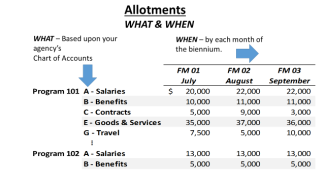DES wants to hear from you!
We are improving our website and want to know how it can better serve you. Take this survey to make des.wa.gov more useful.
We are improving our website and want to know how it can better serve you. Take this survey to make des.wa.gov more useful.
Agency allotments are often referred to as the agency's "spending plan". They are the agency's plans for what to spend their limited recourses on and when to incur these expenses. Good allotment planning allows management to make confident decisions, knowing that resources will be available when needed to support these decisions.
Additionally, allotments serve as a measuring stick upon which to compare actual expenditures and revenues. Differences between allotments (planned expenditures and revenues) and actual expenditures and revenues are referred to as variances. Agencies are expected to monitor variances and to take management action as appropriate.
Per OFM's allotment instructions, allotments are a detailed plan of expenditures authorized in the budget, the assumed revenue estimates, and the related FTE estimates. Allotments must:
Allotments, or the agency's "spending plan", should be considered policy and mirror the agency's strategic plan. For example, if an agency's strategic plan includes public outreach, resources should be clearly allotted to expenditures that support that outreach.

Allotment plans are reviewed by OFM, and upon approval, remain accessible and are monitored by both the executive and legislative branches, as well as the public. This monitoring helps ensure appropriations are used only for purposes that meet legislative intent, sufficient funding exists to allow the state to incur financial obligations, and changes in the original budget assumptions are communicated and understood. Adjustments to approved allotments may be submitted to OFM quarterly.
Initial allotments are typically due to OFM in early August after the biennial budget is passed. Refer to these Accounting and Budget Dates of Interest for specifics.